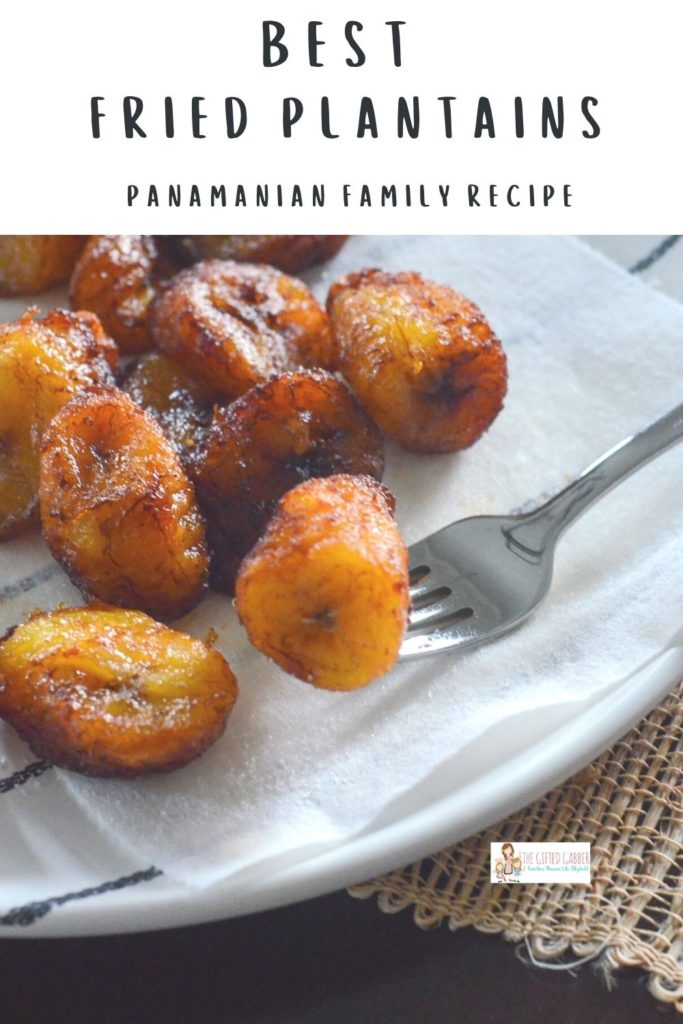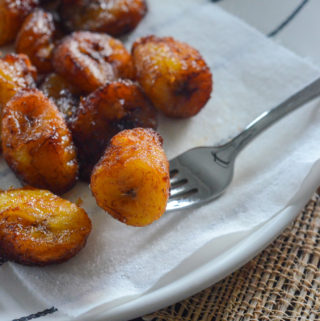Being part of a bi-cultural family has brought me many interesting experiences. And the twice weekly eatings of these delicious Panamanian fried plantains – platanos maduros – are no exception!

On the one hand, there is the Latin flair gleaned from my mom’s upbringing in her native Panama. But, most people who visit my parents’ home likely note, upon first impression, a stronger southern influence, given the way my dad proudly labels himself a “redneck hippy.” (Insert multiple question marks here.) However, there are some glaring Panamanian pops that dominate the household. Plantain bananas are one of them. Mom does well with balancing her Panamanian specialties with Dad’s southern favorites, like fried chicken and hot-water cornbread.
Mom serves these delicious platanos maduros at least once a week. I recall getting tired of eating them on the regular as a kid. But now, in grown up life, my heart jumps a bit when Mom says she is making maduros. Now, I even whip them up myself.
What is the Difference Between Platanos Maduros (Yellow/Mature Plantains) and Tostones (Green Plantains)? – Platanos Maduros Vs. Platanos Verdes
Well, I kind of just told you the answer in my heading, right? The word “maduros” means ripe or mature. The yellow, ripe platanos maduros must be cooked a different way that the platanos verdes – which are unripened (green) plantains.
Seriously, there are no frills or fanciness to our Panamanian platanos maduros. They are simply ripened plantains, sliced and fried in oil. We don’t get the green unripened ones for this particular cooking style of plantains. You can see how to cook green plantain bananas in my patacones – fried plantains post. In many Latin American countries, prepared green plantains are referred to as tostones. However, in Panama they are called patacones.
While you are on a platanos kick, you might want to checkout my platanos en tentacion. This recipe makes for a perfect plantain dessert!
Learn more about the nutritional information of plantains here.
The Secret to Caramelized Platanos (Platanos Caramelizados)
For the longest time, I could not get my platanos maduros to come out as caramelized platanos. Rather, they had a chewy and somewhat tough texture. And the look of them was more dry than caramelized. Granted, they were still delicious. But something wasn’t quite right. They were not like my mom’s fried plantains!
Finally, I figured it out. If you are not working with actual black plantains, your platanos maduros will not be caramelized. They will still be tasty, but they will lack the caramelized texture/flavor. Sometimes, I try to rush my plantains. Rather than waiting for them to turn black, I used to go ahead and fry them when they turned a dark yellow. Wait, folks. Just wait.
For my pictures in this post, I used these platanos. They were blackening but were not totally black yet. Even more black would have been best!

How to Cook Ripe Plantains – Fried Plantains
First, I heat a skillet of oil over medium-high heat. My mom prefers to use her cast iron. Since I have a glass top stove at my house, I don’t cook on the stove top with cast iron. I use my favorite enamel skillet instead. I took these pictures at the spur of the moment my parents’ house while Mom and I were cooking so you will see a cast iron.
Next, I slice the banana into 1/2 to 1 inch slices at a diagonal. Perfecting slices doesn’t suit me. Isn’t irregularity so much more interesting?

Into the hot oil, the slices go, slowly and carefully. At this time, I fry them about 2-3 minutes on each side until they are a nice golden brown with a slight blackness to the edges.


Then, I carefully remove them with a slotted spoon or spatula.

Next, I place them on a plate covered with paper towels to help absorb the oil. At this point, I add a little sea salt or table salt while they are still hot.

Ay…que rico! A perfect and simple side item with no frills. Often, these fried plantains are served with fancy bells and whistles at gourmet Caribbean or Latin restaurants. And while I’ve never met a maduro I didn’t like, I still prefer them plain and simple – kind of like a good ole’ standard French fry. When prepared this way, they should have a slightly crunchy outside with a chewy inside. Some people in Panama eat platanos maduros – but especially patacones – with ketchup or with a ketchup-mayo blend (half of each, combined).


Platanos Maduros – Fried Plantains
Ingredients
Fried Plantains
- 2 Plantain bananas ripe; black or dark
- ½ cup Vegetable oil you may need a little more
- 1 tsp Salt
Ketchup Mayo Sauce
- ½ cup Ketchup
- ½ cup Mayonnaise
Instructions
- Heat oil in a medium frying pan with a high rim.
- Peel and slice plantain into diagonal slices, about 1/2 inch thick.
- Fry 2-3 minutes on each side until edges are brown.
- When both sides are evenly browned, remove slices with a slotted spoon or spatula and place on a plate lined with paper towels.
- Sprinkle slices with salt, if desired.
- Serve plantains with ketchup or with a ketchup mayo sauce.
Ketchup Mayo Sauce
- In small bowl, mix ketchup and mayonnaise together.
Nutrition
Well, what are some multicultural foods eaten in your home?

Varsha
thanks for sharing your thoughts with us it was very helpful nd continue to sharing such post with us.
Donna Dunn
I actually got plantains by mistake when ordering groceries online. I thought I was ordering bananas. This led me to Pinterest to find “What in the world I’m suppose to do with these things”! Now I have another question. You have explained about the green vs the dark or black (ripe) plantains, but mine are yellow with some green on them. Do I treat them as green plantains?
Thanks in advance!
The Gifted Gabber
Oh, my gosh, Donna! I’m so sorry for just now responding. For some reason, I never saw this comment when you added it. Yes, I would treat the yellowish plantains more like the green ones (for maduros) rather than treating them as the black ones (for patacones/tostones). I hope you have taking a liking to them!
Frances DTWTMSE
Following you too, and would love to invite you to http://multiculturalkidblogs.com/join-multicultural-kid-blogs/ Thanks!
Frances DTWTMSE
Hi there! Thanks for stopping by my blog http://discoveringtheworldthroughmysonseyes.blogspot.com/ of course, I hopped on over to check out yours and clicked on "culture" and found this wonderful post on "amarillos!" This is my comfort food, and takes me back to Puerto Rico.
Amy
Katharine,
At some of the Cuban restaurants I've been to, the maduros have been served with special sauces. Also, they are sometimes tossed with brown sugar before fried to help carmelize them. Some people prefer to use butter instead of oil. But we always do ours this way – with just vegetable oil and the plantains. Salt, if you want it. Delicious!
I've never given brats and kraut much of a chance. I find that my adult palate is so different from when I was younger, so maybe it is worth trying it out again!
Sarah Shotts
Awesome! I didn't realize we aren't FB friends yet. Just sent a request and then I can add you. 🙂
Katharine
What are some of the fancy bells and whistles restaurants use? I want my husband's first encounter with this idea to be, umm, funner? 😉
Also, you asked, and one multi-cultural dish we love is brats and kraut. Mmmm! I found some brats that are part venison, and cannot help but feel they are the most authentic I've ever tasted. 🙂
Amy
Sarah, I will be happy to join up with The Mixing Bowl!
Sarah Shotts
Try them out stupid auto correct.
Sarah Shotts
Love this! Maybe we'll try email out. 🙂
I'd love for you to share this in The Mixing Bowl (my FB group for Project STIR) https://www.facebook.com/groups/1487870738165234?
And any other heirloom recipe blogs as you write them. 🙂
Amy
I've never tried them that way, Jeanetta! Going to have to check that out. Thanks for stopping by!
Jeanetta
Plantains are a favorite of mine. Love them with Honduran sour cream.